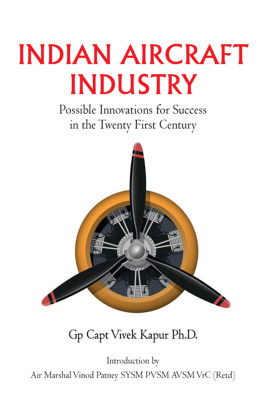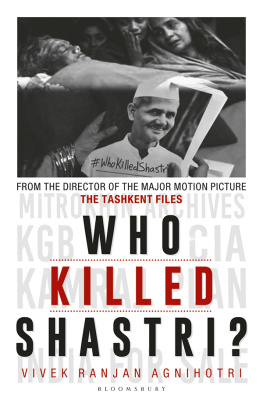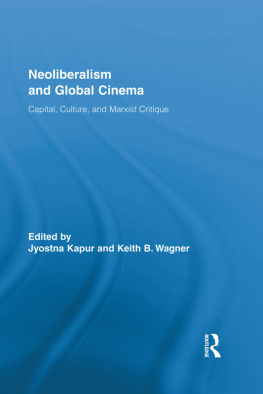
| INDIAN
AIRCRAFT
INDUSTRY |
Possible Innovations for Success
in the Twenty-First Century |
Group Captain Vivek Kapur, Ph. D.
Introduction by
Air Marshal Vinod Patney SYSM PVSM AVSM VrC (Retd)

Copyright 2018
Centre for Air Power Studies, New Delhi

The Centre for Air Power Studies is an independent, non-profit, academic research institution established in 2002 under a registered Trust to undertake and promote policy-related research, study and discussion on the trends and developments in defence and military issues, especially air power and the aerospace arena, for civil and military purposes. Its publications seek to expand and deepen the understanding of defence, military power, air power and aerospace issues without necessarily reflecting the views of any institution or individuals except those of the authors.
Centre for Air Power Studies
P-284, Arjan Path
Subroto Park
New Delhi 110010
Tele: (91-11) 25699131
E-mail:
website: www.capsindia.org
All rights reserved. No part of this book may be reproduced or transmitted in any form or by any means, electronic or mechanical, including photocopying, recording or by any information storage and retrieval system, without permission in writing.
ISBN978-93-86288-68-4Hardback
ISBN978-93-86288-69-1ebook
Published in India by Kalpana Shukla

KW Publishers Pvt Ltd
4676/21, First Floor, Ansari Road
Daryaganj, New Delhi 110002
Phone: +91 11 23263498/43528107
Marketing:
Editorial:
Website:www.kwpub.com

CENTRE FOR AIR POWER STUDIES
VISION
To be an independent centre of excellence on national security contributing informed and considered research and analyses on relevant issues.
MISSION
To encourage independent and informed research and analyses on issues of relevance to national security and to create a pool of domain experts to provide considered inputs to decision-makers. Also, to foster informed public debate and opinion on relevant issues and to engage with other think-tanks and stakeholders within India and abroad to provide an Indian perspective.
Dedication
This book is dedicated to all the air warriors who continue serve the country with utmost dedication and selflessness despite the hardships associated with military life.
Contents
List of Tables and Figures

| Acknowledgements |
At the outset, I owe thanks to the Director General, Centre for Air Power Studies (DG CAPS) for permitting me to carry out this research project. DG CAPS also supported me throughout, with assistance in making material available, both in Delhi and on research visits to other locations in the country. I also owe gratitude to my supervisor Air Vice Marshal (AVM) Manmohan Bahadur (Retd) and Air Mshl KK Nohwar (Retd) for the encouragement, guidance, assistance, and advice provided by them. My peers at CAPS provided continuous help in carrying out peer reviews of my work and in giving invaluable advice and assistance over the two years that this project took.
I am grateful to my parent organisation, the Indian Air Force (IAF) for enabling me to undertake this research programme at CAPS. In the IAF, special mention is merited by officers at the Personnel Branch at Air Headquarters (HQ). Mrs. Sushma Zutshi, the librarian at CAPS and her staff were very helpful, especially in ensuring availability of all the books and other documents required by me for research, through all the means at their disposal, including inter-library loans. My colleagues at CAPS helped in great measure, spending innumerable hours of their free time reading through my writing and carrying out peer reviews, with useful suggestions for improvement of the output.
I am very grateful to Air Chief Marshal (ACM) S Krishnaswamy (Retd), Air Mshl N.V. Tyagi (Retd), Air Mshl P. K Mehra (Retd), Air Mshl S. Mukherji (Retd), and Air Vice Marshal (AVM) M. Bahadur (Retd) for granting me personal interviews in which they shared their valuable thoughts and experiences to enrich this study. Transcripts of the interviews are available with me.
While the submission of this project is done in my individual capacity, it has been made possible by unstinting support from several quarters. All the faculty and staff at CAPS and my peers and seniors at Air HQ, IAF, and CAPS have been extraordinarily supportive and have invariably made time available to guide me in continuing the required research and writing.
Man first took to the air in a powered heavier than air machine less than 114 years ago. On December 17, 1903, the Wright Brothers flew the Wright Flyer 1 near Kitty Hawk in North Carolina, USA, for 20 seconds, reached an altitude of 20 ft and covered a distance of 120 ft. The feat immortalised their name in aviation history. In 1906, after another successful flight in France, Lord Northcliffe, the press baron, with great prescience, opined, The news is not that man can fly but that England is no longer an island. Prophetic words, indeed. Aviation came to India relatively early. In December 1910, a mere seven years after the historic flight of the Wright Brothers, a Bleriot 10 aircraft flew from Allahabad. This is again a notable date as it represented the first flight in Asia. Thus, in Asia, aviation was introduced in India. Early aviation history had a charm of its own. Flying defied gravity and purportedly the laws of nature as well. It had an admixture of glamour and adventure. Soon, its potential and effectiveness were recognised and aviation altered the means and methods of war. Today, in an air war, an incremental or new capability has an impact many times greater than its intrinsic value. Thus, there is a requirement that we field, at all times, state-of-the-art capability or as near to it as possible or affordable. How can this be brought about? A look at our aviation history could give us some pointers.
A fledgling aviation industry was established in India reasonably early in comparison to other countries in the neighbourhood or even at distant locations. Unfortunately, the headstart was somewhat squandered and the Indian aviation industry has fallen well behind many other countries where aviation was introduced much later.



















